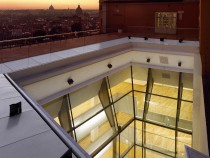
© Andrea Jemolo/ Bibliotheca Hertziana
Considering the narrative and the limitations, the spatial breadth achieved by Navarro Baldeweg – the winner of the competition – in the new building is truly astonishing. Now the architecture finally corresponds to the library’s status as prestigious meeting place. Galleries wrap around three sides of the study zone, giving the space a theatrical feel. The levels are stepped and allow a visitor to the library to make an appearance – or a disappearance – in a variety of ways: one may make his or her presence known by standing at the balustrade, may disappear into the stacks, get a glance of another level through the many openings, or retreat behind a wooden-clad wall with a rare book. The warm wood tones and white-slurried bricks – which cloak the steel-composite structure – create an airy interior atmosphere. The library users, who had been exiled to dreary temporary quarters during the ten-year-long construction phase, now benefit from this complex spatial construct in which every type of personality can find the ideal microcosm.This amazing architectural liberation was possible because Baldeweg saw the facades and adjacent buildings not as limitations, but as inspiration. The most beautiful manifestation of this is perhaps the series of small round windows integrated in the pediments above the existing windows in the piano nobile along Via Gregoriana. Inside they metamorphose into bull’s eyes – situated precisely at the eye level of a person seated in the study zone on the third floor.






